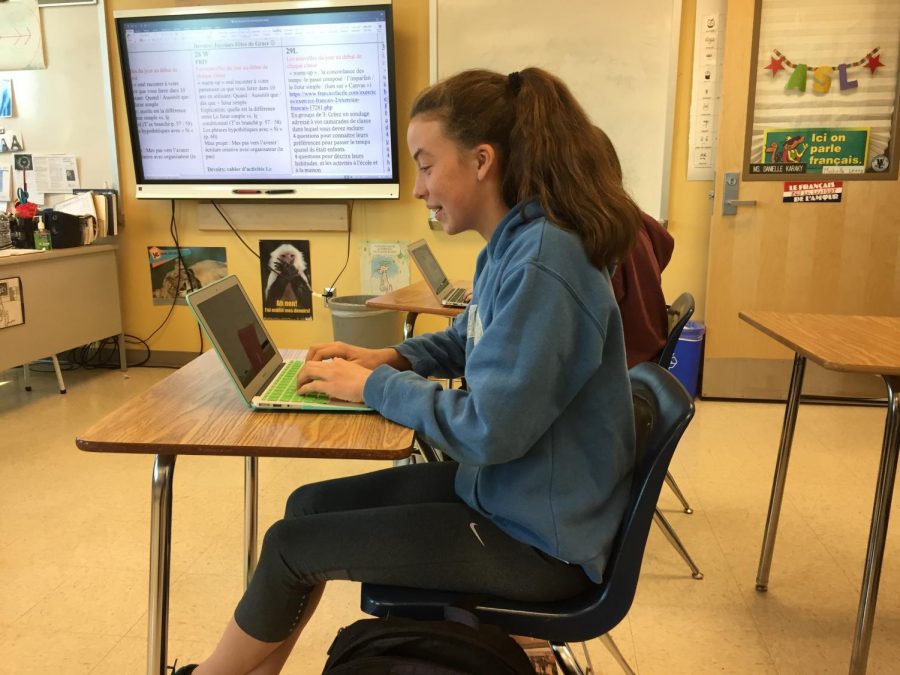GlobalProtect doing more harm than good
New cyber security measure causes issues for students
Sophomore Rebecca Stewart uses her school computer during class. Many students have had difficulties in connecting to the Internet due to GlobalProtect.
After computer re-imaging at the end of the 2016-17 school year, a new program called GlobalProtect was installed by Arlington Public Schools (APS) on all student Macbook Airs. The software is a Virtual Private Network (VPN) developed by Palo Alto Networks, and was designed to provide a layer of security and filter digital content on student computers. However, since implementation, several problems with the software have persisted and provided substantial challenges to students looking to access the Internet. While APS has been working hard to fix these problems when they occur, GlobalProtect can still make connecting to the Internet very difficult, and with the increasing amount of online schoolwork assigned to students, this is a problem that can have real-life repercussions on academics at the school.
GlobalProtect was initially added to the computers to improve the system of filtering information. Previously, every student in APS received the same amount of filtering, whether in kindergarten or their senior year. The new program allows filtering to be customized to grade level, so that students in high school can have access to websites that middle or elementary schoolers should not. APS also assesses digital programs so that they fit the needs of students. “APS continuously evaluates the technology we use to deliver services to all students and staff, and works to respond to identified needs or requirements from our parent stakeholder group,” the superintendent’s office said in a statement. “We replaced our previous content filter solution to improve alignment between the filtering solution and stakeholder requirements.”
When planning to implement GlobalProtect, APS tested the program to make sure it would work on student computers. However, when it was put to use across the county, it wasn’t able to handle the number of people trying to access the Internet, causing the initial connectivity problems. After working with Palo Alto Networks, they were able to get the system working. A large number of students use their computers at any given time, given that they were distributed to every high school in the county. “Currently, on a daily basis during peak hours of the night, APS has anywhere between 6,000 to 7,000 students who are accessing the internet at the same time through this service,” the superintendent’s office said.
Due to online platforms like Canvas and Google Classroom, more and more assignments are based around the assumption that students will be able to access the Internet for an extended period of time. Lesson plans can also rely on Internet usage, such as for teachers who administer tests and quizzes through student computers. This makes Internet access a necessity. Many students depend on the computers provided by APS for such access, so when there is an issue with GlobalProtect, they have to figure out another way to get online. “A lot of people really rely on their school computer in order to be able to do a lot of their work, especially with a lot of seniors,” senior Esteban Marmolejo Suarez said. “They’ve had a lot of problems with college apps and whatnot, and a lot of people don’t have another computer that they can use to complete their work, and with GlobalProtect not connecting to a lot of home WiFi, it’s deterring a lot of people from actually being able to complete their assignments.”
Recent efforts have been made on behalf of APS to talk with students about the issues they face when trying to use their computers, such as roundtable discussions. Still, students are frustrated at what they feel is a lack of communication from APS in regards to GlobalProtect and how to fix the issues that have so far come along with it. “I like the system that they’ve set up this year, with having a Canvas channel, but I think maybe just using that more frequently and trying to communicate through the computers and things like that, and maybe making certain things open to feedback,” junior Neeka Samimi said when asked how APS could improve their communication in regards to the computers..
Despite the issues, APS has no plans to remove GlobalProtect. Some form of filtering Internet content in schools must always be in place in accordance with federal law. Students in high schools across the county have been vocal about their dislike of the program, even going so far as to create petitions on change.org, a website for people to influence change in their communities by collecting digital signatures. Junior Ian Page has collected 1,033 signatures on his petition entitled “Stop global protect”. Students have also taken to voicing their frustration through comments on Canvas, a new site used by APS to assign work like homework and quizzes. “There was a period of time I pretty much just couldn’t log onto my computer, so there were some things that I didn’t get to turn in when I would’ve liked to,” Samimi said.
Overall, many students feel as if GlobalProtect is more trouble than it is worth, a sentiment expressed by more than a few students in the “Reasons for signing” section of the change.org petition. Connectivity issues caused by the program can make it difficult for students to complete assignments, despite efforts by the school system to remedy these problems. In a comment on Canvas, Marmolejo Suarez said, “We cannot be content with mediocrity in our schools and we certainly cannot be content with below average technology in our schools.”













